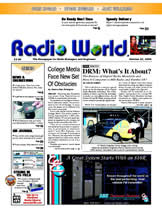|
Follow the Lightning
The KRJM studio facility had been constructed in a
typical manner and enjoyed 20 years of normal service. There was
a ground rod at the base of the STL pole for protection.
You’ll remember I wrote a Radio
World article about grounding in the fall of
2017. It discussed how lightning will usually take the easiest
path to ground. What we often forget is that ground rods, a
standard approach to grounding, are imperfect.
Forensic Analysis
Lightning traveled down the STL pole and ignored the ground rod.
Instead, it followed the STL transmission line to an equipment
rack in the building.
From there, the lightning found ground through the rack’s 120
VAC power circuit, supplied by the building’s electrical load
distribution center (circuit breaker panel). A lot of sensitive
equipment was damaged along this path. Think of your broadcast
equipment as a “fuse” in a series circuit between the lightning
and ground. Poof!
In the final analysis, what was missing was a heavy wire link
between the STL pole ground rod and the studio ground. To say it
another way, the pole and the studio had two different grounds.
They were likely thousands of volts apart during the lightning
strike. Almost everything in the middle was damaged.
Lightning protection
The ideal setup is one in which the STL and all other cables
enter the building near the electrical power panel. All cable
grounds tie to the electrical panel ground and ground rods. It
is a “common point” for all facility grounds. This “star ground”
has a heavy wire from that point to each studio and equipment
rack.
The idea is that studios and racks are “stubs” from the common
ground point. Lightning has no reason to travel to a studio if
there is no ground at that end to go to. That same thinking
applies to transmitter sites, which are even more vulnerable to
lightning damage.
Also, I recommend a flexible #12 wire from each piece of
equipment to the rack it is mounted in. Don’t be fooled into
believing there is a good electrical connection from rack to
equipment because they are screwed together. Paint gets in the
way of a good electrical connection.
Static Dissipaters
It is a well-known fact that sharp points, directed at the sky,
are a good way to dissipate/bleed off static charges, i.e.
reduce voltage between the ground and the sky. It happens
continuously as storms pass by.
The result is either no lightning strike or less energy in a
strike because the voltage is less than it would have been
without dissipators.
|



